How to find: Press “Ctrl + F” in the browser and fill in whatever wording is in the question to find that question/answer. If the question is not here, find it in Questions Bank.
NOTE: If you have the new question on this test, please comment Question and Multiple-Choice list in form below this article. We will update answers for you in the shortest time. Thank you! We truly value your contribution to the website.
CCNP Enterprise: Advanced Routing (Version 8.0) – BGP Exam
1. Refer to the exhibit. Autonomous system 65500 is routing traffic between two external BGP autonomous systems, autonomous system 65200 and autonomous system 65100. Synchronization is disabled on BGP in autonomous system 65500. Which routers should have IBGP peer relationships for routing between autonomous system 65200 and autonomous system 65100 to work properly?
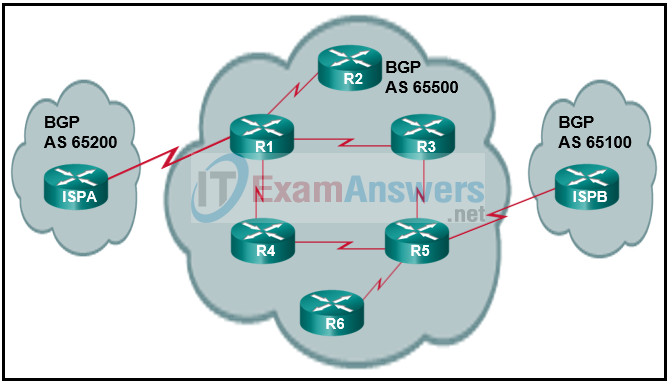
- R1 and R5
- R1, R3, R4, and R5
- R1, R3, and R4
- ISPA, R1, R5, and ISPB
Explanation: Within the BGP AS 65500, because synchronization is disabled within the AS, IBGP should be used to establish peer relationships to provide routing service within the AS. R2 and R6 represent subnetworks. Static route and default route configuration provide adequate network access.
2. Match the values to AFI and SAFI extensions supported by MBGP. (Not all options are used.)
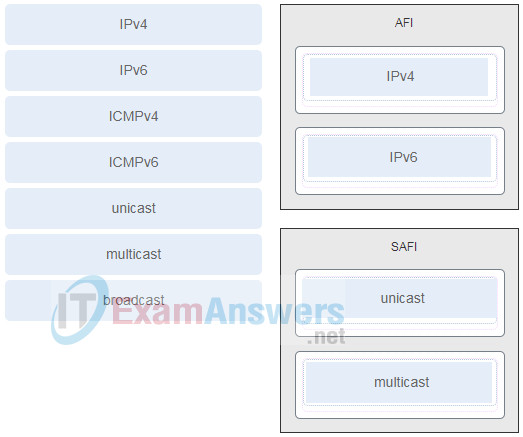
Explanation: To expand the support for multiple network layer protocols to original BGP-4, RFC 2858 added Multiprotocol BGP (MBGP/MP-BGP) capability by adding an extension called the address family identifier (AFI). An address family correlates to a specific network protocol, such as IPv4 or IPv6, and additional granularity is provided through a subsequent address family identifier (SAFI) such as unicast or multicast.
3. Refer to the exhibit. A network administrator issues the show bgp ipv4 unicast command to check the routes in the BGP table. What does the indication of 0.0.0.0 under Next Hop mean?

- The route is learned through a static route.
- The route is originated from a connected network to the router.
- The route is the best route for the network prefix.
- The route is learned through IGP.
Explanation: As the BGP prefix is installed into the Loc-RIB table, the following BGP PAs are set, depending on the RIB prefix type:
- Connected network : The next-hop BGP attribute is set to 0.0.0.0, the BGP origin attribute is set to i (IGP), and the BGP weight is set to 32,768.
- Static route or routing protocol : The next-hop BGP attribute is set to the next-hop IP address in the RIB, the BGP origin attribute is set to i (IGP), the BGP weight is set to 32,768, and the MED is set to the IGP metric.
4. Refer to the exhibit. Which two configurations will allow router R1 to establish a neighbor relationship with router R2? (Choose two.)

R2(config)# router bgp 65002
R2(config-router)# network 192.168.20.0
R2(config-router)# neighbor 209.165.200.225 remote-as 65001
R2(config)# router bgp 65002
R2(config-router)# network 192.168.10.0
R1(config)# router bgp 65001
R1(config-router)# network 192.168.20.0
R2(config)# router bgp 65002
R2(config-router)# network 192.168.10.0
R2(config-router)# neighbor 209.165.200.226 remote-as 65002
R1(config)# router bgp 65001
R1(config-router)# network 192.168.10.0
R1(config-router)# neighbor 209.165.200.226 remote-as 65002
R1(config)# router bgp 65002
R1(config-router)# network 192.168.20.0
R1(config-router)# neighbor 209.165.200.225 remote-as 65001
Explanation: To configure EBGP, the router bgp command is followed by the AS number in which the router resides. Conversely, the neighbor command contains the AS number to which the remote router belongs.
5. Refer to the exhibit. A network administrator is configuring BGP on a router. What network layer protocol and function are enabled for the BGP session?
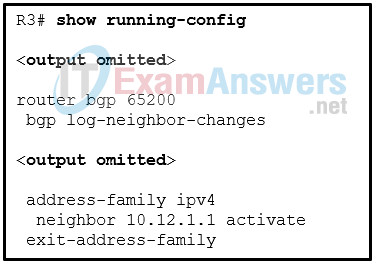
- IPv4 protocol with all the functions.
- IPv4 protocol with TCP connections.
- IPv4 protocol with both unicast and multicast communications.
- IPv4 protocol with unicast communication.
Explanation: The address family is initialized by using the BGP router configuration command address-family afi safi . On IOS and IOS XE devices, the default subsequent address family identifier (SAFI) for the IPv4 and IPv6 address families is unicast and is optional.
6. A large company is deploying network connectivity to multiple ISP sites. What are two considerations for running IBGP on internal routers compared with redistributing a BGP table into an IGP? (Choose two.)
- capability of custom routing decisions
- scalability to handle a large number of routes
- faster convergence after network changes
- capability of load balancing over multiple routes
- lower AD value
Explanation: When a company exchanges routes with multiple ISP sites, running IBGP on internal routers provides a better solution with the following features:
- Scalability – The internet has 800,000+ IPv4 network prefixes and it continues to increase in size. IGPs cannot scale to that level of routes.
- Custom routing – Link-state and distance vector routing protocols use one or more specific metrics as the primary method for route selection. IGP protocols always use this routing pattern for path selection. BGP uses multiple steps to identify the best path and to manipulate the path for a specific prefix based on the network layer reachability information (NLRI). The NLRI includes the network prefix, prefix length, and any BGP path attributes (PAs) for a specific route. If the route was considered from the prospective of an IGP, the chosen path could be considered longer or suboptimal than a path chosen by BGP.
7. Which BGP routers will become peers and share routing information?
- BGP routers that share routing information with all routers in the same AS by default
- BGP routers that are configured with the same peer command
- BGP routers that are configured with the same network command
- BGP routers that are configured with the neighbor command
Explanation: In BGP configuration, the BGP router configuration command neighbor ip-address remote-as as-number is used to identify the IP address and autonomous system number associated with the BGP neighbor.
8. Refer to the exhibit. Given the above configuration commands, which two statements are true? (Choose two.)

- RTA will set the atomic aggregate attribute to true.
- RTA will create the supernet route even if no other specific routes belonging to the supernet are in the route table.
- RTA will send the supernet route as well as all other specific BGP routes that belong to that supernet.
- RTA will send the supernet route and suppress the more specific routes known to BGP.
- RTA will set the atomic aggregate attribute to false.
Explanation: Route summarization on BGP edge routers via dynamic method is configured by specifying an aggregation network prefix. The aggregate-address command advertises the aggregated route (the supernet) in addition to the specific original component network prefixes. By using the optional summary-only keyword, the component network prefixes in the summarized network range are suppressed. When a BGP router summarizes a route, it does not advertise the AS_Path information from before the aggregation. This effect is indicated by the atomic aggregate attribute. The atomic aggregate attribute indicates that a loss of path information has occurred.
9. A network administrator is configuring an ACL to match networks for BGP route filtering. The administrator creates an ACE permit ip 10.0.64.0 0.0.63.0 255.255.255.0 0.0.0.192 . Which two networks match the ACE? (Choose two.)
- 10.0.128.0/25
- 10.0.126.0/25
- 10.0.64.0/24
- 10.0.130.0/24
- 10.0.63.0/26
Explanation: One method for conditional matching of routes in BGP is through extended ACLs. When extended ACLs are used for this purpose, the source fields match against the network portion of the route, and the destination fields match against the network mask. The network portion of the matching networks is 10.0.64.0 through 10.0.127.0. The network mask portion is /24 through /26.
10. Refer to the exhibit. A network administrator is configuring BGP route filtering on R1. The objective is to advertise only locally originated routes to its neighbor to avoid undesirable transit connectivity. Which AS path ACL should the administrator configure?
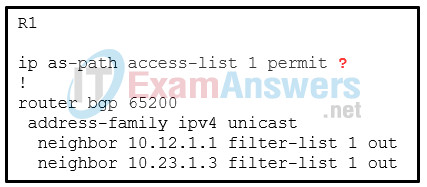
- ip as-path access-list 1 permit _$
- ip as-path access-list 1 permit ^$
- ip as-path access-list 1 permit *$
- ip as-path access-list 1 permit [^$]
Explanation: To restrict traffic to only locally originated traffic, configure the AS path ACL using the regex pattern ^$.
11. Which type of BGP peer templates define configuration settings specifically for the address family policy?
- peer policy
- peer connection
- peer session
- peer group
Explanation: There are two types of BGP peer templates:
- Peer session – This type of template involves configuration settings specifically for the BGP session.
- Peer policy – This type of template involves configuration settings specifically for the address family policy.
12. A network administrator is configuring route summarization for received routes before advertising to the next peer with the commands:
R1(config)# router bgp 65500
R1(config-router)# aggregate-address 172.16.0.0 255.255.240.0 as-set summary-only
R1(config-router)# end
How will the aggregate route be advertised after the commands are entered?
- The aggregate route will be advertised with previous BGP path information.
- The aggregate route will be advertised together with the smaller component network prefixes.
- The aggregate route will be advertised as an atomic aggregate route.
- The advertised aggregate route will increase the hop counts as it indicates multiple autonomous systems.
Explanation: Route summarization on BGP edge routers via dynamic method is configured by specifying an aggregation network prefix. The aggregate-address command advertises the aggregated route in addition to the specific original component network prefixes. By using the optional summary-only keyword, the component network prefixes in the summarized network range are suppressed. When a BGP router summarizes a route, it does not advertise the AS_Path information from before the aggregation. This is indicated by the atomic aggregate attribute. To keep the BGP path information history, the optional as-set keyword may be used with the aggregate-address command. The AS_Path settings from the original prefixes are stored in the AS_SET portion of the AS_Path. The AS_SET, which is displayed within brackets, only counts as one hop, even if multiple autonomous systems are listed.
13. Refer to the exhibit. A network administrator is troubleshooting BGP configuration and wants to display only routes with AS 300 being the first AS in the AS_Path value. Which regular expression should the administrator use in the command show bgp ipv4 unicast regex regex-pattern ?
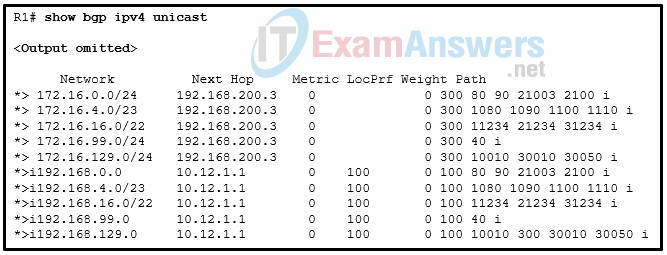
- show bgp ipv4 unicast regex _300_
- show bgp ipv4 unicast regex $300
- show bgp ipv4 unicast regex .300.
- show bgp ipv4 unicast regex ^300_
Explanation: In troubleshooting BGP, Regular expressions (regex) can be used to parse through the large number of available ASNs. Regular expressions are based on query modifiers used to select the appropriate content. The regex pattern ^300_ indicates to only include the lines that list the exact phrase of 300 as the first AS. Some regex query modifiers are as follows:
_ (underscore) – matches a space
^ (caret) – indicates the start of a string
$ (dollar sign) – indicates the end of a string
. (period) – matches a single character, including a space
14. A network administrator is configuring a BGP router with the neighbor 10.12.1.2 maximum-prefix 10 command. What will happen when the peer at 10.12.1.2 advertises more than 10 routes?
- The router drops any further advertisements from the peer.
- The router sends a warning message to the peer.
- The router closes the BGP session for 30 seconds and then restarts the BGP peering process.
- The router moves the peer to the Idle state and closes the BGP session.
Explanation: The prefix restrictions can be put on a BGP neighbor by using the BGP address family configuration command neighbor ip-address maximum-prefix prefix-count [ warning-percentage ] [ restart time ] [ warning-only ]. When a peer advertises more routes than the maximum prefix count, the router moves the neighbor to the Idle (PfxCt) state in the finite-state machine (FSM), closes the BGP session, and sends out the appropriate syslog message.
15. Which three statements describe the weight attribute for BGP? (Choose three.)
- It is a Cisco-defined attribute.
- It is a well-known discretionary path attribute and is included with path advertisements throughout an AS.
- It is not advertised to other routers.
- It is a 16-bit value assigned locally on the router.
- It is not advertised between eBGP peers and is typically used to influence the next-hop address for outbound traffic.
- It is a nontransitive attribute that uses a 32-bit value called metric.
Explanation: BGP weight is a Cisco-defined attribute and the first step for selecting the BGP best path. Weight is a 16-bit value (0 to 65,535) assigned locally on the router; it is not advertised to other routers.
16. Refer to the exhibit. BGP sessions are established between all routers. RTC receives route updates for network 209.165.200.224/27 from autonomous system 300 with the weight attribute set to 3000. RTB also learns about network 209.165.200.224/27 from autonomous system 200 with a weight of 2000. Which router will be used by RTA as a next hop to reach this network?
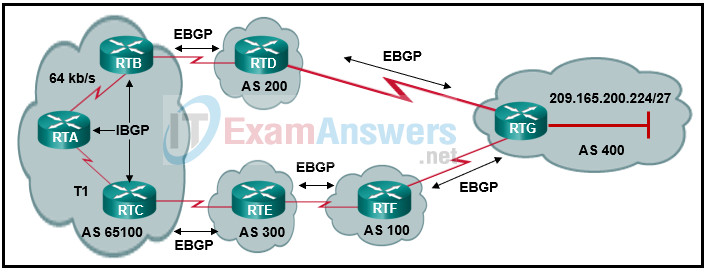
- RTB because of the slow 64 kbps link
- RTC because of the highest weight
- RTB because of the shortest AS_Path
- RTC because of the longest AS_Path
- RTC because of the T1 link
- RTB because of the lowest weight
Explanation: The BGP best-path algorithm uses attributes for the best-path selection. The top 5 attributes, ranked in order of consideration, are the following:
1. Weight.
2. Local preference.
3. Local originated (network statement, redistribution, or aggregation).
4. AIGP.
5. Shortest AS_Path.
BGP weight is a Cisco-defined attribute and is a 16-bit value assigned locally on the router; it is not advertised to other routers. Thus, the weight attributes as specified in RTD and RTE have no effect in RTA for determining the best outbound path. Assuming that the attributes in ranks 2 to 4 are not specified, the shortest AS_Path attribute is used to choose the outbound path when two paths are available.
17. Which class of BGP path attributes is not recognized by all BGP implementations but must be passed on to the next AS?
- optional transitive
- optional nontransitive
- well-known discretionary
- well-known mandatory
Explanation: The BGP prefix path attributes are classified as follows:
- Well-known mandatory – supported by all BGP implementations and advertised between autonomous systems
- Well-known discretionary – supported by all BGP implementations and not advertised between autonomous systems
- Optional transitive – not supported by all BGP implementations and advertised between autonomous systems
- Optional nontransitive – not supported by all BGP implementations and not advertised between autonomous systems
18. Refer to the exhibit. Which two statements describe the result of the configuration? (Choose two.)

- Received routes that match the prefix list are set with a local preference value of 250.
- Received routes from the neighbors that match the IP address in the prefix list are set with a local preference value of 250.
- Received routes that match the prefix list are treated with higher priority than the weight attribute when calculating the best-path.
- Received routes that do not match the prefix list are set with a local preference value of 100.
- Received routes from the neighbors that do not match the IP address in the prefix list are set with a local preference value of 100.
Explanation: Local preference (LOCAL_PREF) is a well-known discretionary path attribute and is included with path advertisements throughout an AS. Local preference can be set for specific routes by using a route map or for all routes received from a specific neighbor. If an edge BGP router does not define the local preference upon receipt of a prefix, the default local preference value of 100 is used during best-path calculation. Setting the local preference for specific routes is accomplished by using a route map or route policy with the action set local-preference preference . Setting the local preferences for all routes received by a neighbor can be accomplished by using the BGP address family configuration command neighbor ip-address local-preference preference .
19. A network administrator is configuring BGP multipathing by using the maximum-paths 5 command. Which statement describes the result of this command?
- Up to 10 combined IBGP and EBGP paths are allowed to be installed in the RIB.
- Up to 5 EBGP paths are allowed to be installed in RIB.
- Up to 5 IBGP paths are allowed to be installed in RIB.
- Up to 5 combined IBGP and EBGP paths are allowed to be installed in RIB.
Explanation: EBGP multipathing can be enabled by using the BGP configuration command maximum-paths number-paths . The number of paths indicates the allowed number of EBGP paths to install in the RIB. The command maximum-paths ibgp number-paths sets the number of IBGP routes to install in the RIB. The commands are placed under the appropriate address family.
20. Which statement describes a feature of BGP nontransitive path attributes?
- Their changes only influence the local BGP routing policy.
- They are used when the enterprise AS carries transitive data traffic.
- They are imported to an IGP when IBGP and IGP are used within an AS.
- They are advertised between autonomous systems.
Explanation: BGP path attributes (PAs) can be either transitive or nontransitive. Transitive PAs are carried from one AS to another AS and those changes could affect downstream routing for other SPs too. Nontransitive PAs influence the routing policy only within the organization. All the BGP path attributes cannot be maintained within IGP protocols. Only BGP can maintain the path attribute as the prefix is advertised from one edge of the AS to the other edge.
21. What is the purpose of using the multi-exit discriminator attribute on multiple BGP routers in an AS?
- to help determine the best-path to a destination network
- to advertise the peer group to another AS
- to influence the inbound traffic flow from a different AS
- to set the preference of an internal router to affect sending outbound traffic
Explanation: The BGP multi-exit discriminator (MED) attribute is nontransitive. The purpose of using MED is to influence traffic flows inbound from a different AS. A lower MED is preferred over a higher MED.
22. What are three issues that may cause the forming a BGP neighbor relationship to fail? (Choose three.)
- TCP port 169 being blocked by a firewall
- broken Layer 3 connectivity
- the path to the neighbor being through the default route
- interface being down
- only iBGP being configured on the router
- the holddown timer not matching between BGP peers
Explanation: Some of the reasons that a BGP neighbor relationship might not form are as follows:
- Interface is down : The interface must be up/up.
- Layer 3 connectivity is broken : The IP address for a neighbor must be reachable.
- Path to the neighbor is through the default route : A neighbor must be reachable using a route other than the default route.
- ACLs : An access control list (ACL) or a firewall may be blocking TCP port 179.
- Timers : Timers do not have to match; however, if the minimum holddown from neighbor option is set, it could prevent a neighbor adjacency.
23. Refer to the exhibit. A network administrator is troubleshooting a BGP adjacency issue between routers R2 and R5. R2 uses loopback0 interface 2.2.2.2 and R5 uses loopback0 interface 5.5.5.5 in the neighbor ip_address remote-as as_number statement in the configuration. However, an adjacency does not form. Which action can the administrator take to resolve the issue?
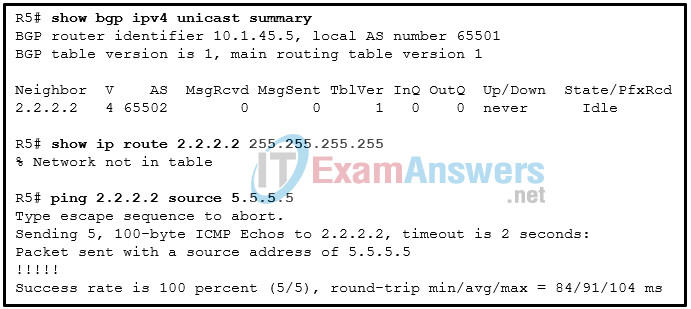
- Add a static route on R5 to reach IP address 2.2.2.2.
- Issue the neighbor 5.5.5.5 remote-as 65501 command on R2.
- Add a default route on R2 toward R5.
- Ensure that the interface with IP address 10.1.45.5 is up/up.
Explanation: Two BGP routers do not have to be directly connected or in the same subnet to form a BGP neighbor relationship; however, Layer 3 connectivity is required. For a router to have Layer 3 connectivity to the neighbor, it needs to have a route in the routing table that points to the neighbor router. The fact that there is no route in the routing table on R5 to reach 2.2.2.2 and R5 can ping R2 with the ping 2.2.2.2 source 5.5.5.5 command indicates that R5 can reach R2 via the default route configured on R5. BGP does not consider the default route a valid route for forming an adjacency.
24. A network administrator is troubleshooting a BGP network where some BGP routes are missing from BGP tables. The administrator has verified that BGP peers were formed as expected. What are two possible reasons that routes would not appear in the BGP table or the routing table? (Choose two.)
- the default route being used to reach a neighbor
- route filtering configuration
- misconfigured timers
- better source of information available
- TCP port 179 being blocked by an ACL or a firewall
Explanation: BGP peers are the foundation of BGP information sharing. Without peers, BGP will not learn BGP routes. Some common reasons that BGP routes might be missing from either the BGP table or the routing table include the following:
- Missing or bad network mask command : An accurate network command is needed to advertise routes.
- Next-hop router not reachable : To use a BGP route, the next hop must be reachable.
- BGP split-horizon rule : A router that learns BGP routes through an IBGP peering does not share those routes with another IBGP peer.
- Better source of information : If the same network is learned from a more reliable source, it is used instead of the BGP-learned information.
- Route filtering : A filter might be preventing a route from being shared with neighbors or learned from neighbors.
25. Refer to the exhibit. A network administrator issues the show bgp ipv4 unicast | begin Network command to check the routes in the BGP table. What does the symbol ? at the end of a route indicate?
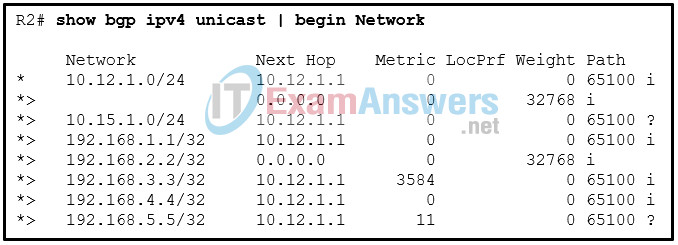
- The route is originated from a connected network to the router.
- The route is learned through a static route.
- The route is the best route for the network prefix.
- The route is redistributed into BGP.
Explanation: The origin is a well-known mandatory BGP path attribute used in the BGP best-path algorithm. A value of i represents an IGP, e indicates EGP, and ? indicates a route that was redistributed into BGP.
26. Refer to the exhibit. A network administrator issues the show bgp ipv4 unicast 10.1.1.0 command on router R1 to verify the network 10.1.1.0 in the BGP table. The administrator notices that there are two routes to reach the network and the route through the neighbor 2.2.2.2 is the best route. Which configuration change can the administrator make on R1 to make the route through 3.3.3.3 the best-path?

- Set weight to 10 for the route through 3.3.3.3.
- Set multi-exit discriminator to 50 for the route through 3.3.3.3.
- Change the BGP RID 2.2.2.2 to 4.4.4.4.
- Set local preference to 50 for the route through 3.3.3.3.
Explanation: Cisco routers review BGP attributes in the following ranked order when deciding which path is the best-path:
- Prefer the highest weight .
- Prefer the highest local preference .
- Prefer the route originated by the local router.
- Prefer the path with the shorter Accumulated Interior Gateway Protocol (AIGP) metric attribute.
- Prefer the shortest AS_Path .
- Prefer the lowest origin code.
- Prefer the lowest multi-exit discriminator (MED).
- Prefer an external path over an internal path.
- Prefer the path through the closest IGP neighbor .
- Prefer the oldest route for EBGP paths.
- Prefer the path with the lowest neighbor BGP RID .
- Prefer the path with the lowest neighbor IP address .
The first path attribute to be checked is the weight. A higher value is better. In this case, no weight is listed because both routes are using the default value 0. Setting the weight higher than 0 will make the route the best-path.
27. Refer to the exhibit. A network technician is verifying the BGP configuration and peer relationship by using the show bgp ipv4 unicast summary command on router R1. Which conclusion can be drawn from the output?

- The neighbor relationship is established but no packet has been exchanged.
- An IBGP connection is being configured between the two routers.
- The AS number used in the neighbor configuration is wrong.
- The local router has no Layer 3 connectivity with the neighbor router.
Explanation: Two BGP routers do not have to be directly connected or in the same subnet to form a BGP neighbor relationship; however, Layer 3 connectivity is required. For a router to have Layer 3 connectivity to another, it needs to have a route in the routing table that points to the neighbor router. If no route to the neighbor exists, a neighbor relationship cannot form. When the show bgp ipv4 unicast summary command to review/verify BGP states is being used, the Idle state under the State/PfxRcd field indicates that the local router is not able to make a TCP connection with the neighbor.
28. Refer to the exhibit. A network administrator issues the show bgp ipv6 unicast | begin Network command on router R1 to verify routes in the IPv6 BGP table. The administrator realizes that the route 2001:DB8:2::/64 learned from router R2 with IP address of 2.2.2.2 will not be installed in the routing table. What is a possible solution to the issue?

- Set weight to 100 on R1 to make the route a best path.
- Create a route map that changes the next hop to a valid IPv6 address and attach it to the IPv6 AF on R1.
- Create a route map that changes the next hop to a valid IPv6 address and attach it to the neighbor statement on R2.
- Set local preference to 200 on R2 to make the route a best path.
Explanation: The show bgp ipv6 unicast command can be used to verify the IPv6 unicast routes that have been learned from all neighbors. The route 2001:db8:2::/64 is the route that was learned from the neighbor at 2.2.2.2. Because the next hop is not reachable, route 2001:db8:2::/64 is not installed in the routing table. The address of ::FFFF:2.2.2.2 is a dynamically generated next hop that was created to replace the original next hop of 2.2.2.2. This occurs because an IPv6 route cannot have an IPv4 next-hop address. To solve this issue, a route map can be created that changes the next hop to a valid IPv6 address and attach it to the neighbor statement. This needs to be done on the router that advertises the route, not on the router receiving the route.
29. What are two reasons why all IBGP routers in a single AS must be in a full mesh topology? (Choose two.)
- IBGP routing requires fault tolerance provided by fully meshed connections.
- Transit traffic is not allowed within the AS where IBGP is used.
- An IBGP router does not prepend the ASN to the AS_Path attribute.
- An IGP provides fast convergence among IBGP routers.
- An IBGP router does not advertise an NLRI received from one IBGP peer to another IBGP peer.
Explanation: IBGP peers do not prepend their ASN to AS_Path because the NLRI would fail the validity check and would not install the prefix into the IP routing table. No other method exists for detecting loops with IBGP sessions and RFC 4271 prohibits the advertisement of an NLRI received from an IBGP peer to another IBGP peer. RFC 4271 states that all BGP routers in a single AS must be fully meshed to provide a complete loop-free routing table and prevent traffic from being dropped.
30. Which two statements describe private BGP communities? (Choose two.)
- Private BGP communities are within the range of 0xFFFF0000 to 0xFFFFFFFF.
- An organization needs to register for a private BGP community.
- A private BGP community uses the first 16 bits to represent its AS and the second 16 bits to represent a pattern.
- Private BGP communities are used to signify no transit networks.
- A private BGP community requires a route map configuration.
Explanation: Private BGP communities follow a convention where the first 16 bits represent the AS of the community organization, and the second 16 bits represent a pattern defined by the originating AS. A private BGP community pattern can vary from organization to organization, does not need to be registered, and can signify geographic locations for one AS while signifying a method of route advertisement in another AS. A private BGP community is set in a route map with the command set community bgpcommunity [ additive ].
31. Which BGP attribute can be configured on IBGP speakers so they will choose a desired path out of the autonomous system to an outside network?
- local preference
- MED
- next hop
- aggregate
Explanation: The local preference attribute indicates the preference for exiting the AS to the destination network. The local preference is not advertised between eBGP peers and is typically used to influence the next-hop address for outbound traffic (that is, leaving an autonomous system). Local preference can be set for specific routes by using a route map or for all routes received from a specific neighbor. A higher value is preferred over a lower value.
32. A network administrator issues the show bgp ipv4 unicast summary command on a router to check the adjacency state with a neighbor router. The value under the State/PfxRcd field shows Active. Which statement describes the status of adjacency between the two routers?
- The adjacency is successfully formed and routing prefixes are exchanged.
- Because the neighbor router has not responded to the open message, the adjacency is not formed.
- Because there is no Layer 3 connectivity between the two routers, the adjacency is not formed.
- The adjacency is successfully formed and the router is waiting for messages from the neighbor router.
Explanation: The State/PfxRcd indicates the current state of the BGP peer or the number of prefixes received from the peer. A value of 0 or another number indicates that the adjacency is successfully formed. The value indicates the number of prefixes received from the neighbor. Messages received and sent between routers are indicated under the MsgRcvd and MsgSent fields. BGP uses TCP to communicate. If there is Layer 3 connectivity, the state value is Idle. If Layer 3 connectivity exists and a three-way TCP handshake is complete, an open message is sent. However, if there is no response to the open message, the state value is Active.
33. A network administrator is configuring IPv6 route summarization on a BGP router. The objective is to aggregate the IPv6 networks from 2001:db8:0:0::/64 to 2001:db8:0:35::/64 into a single summary route. Which aggregation command should be used for the task?
- aggregate-address 2001:db8::/60 summary-only
- aggregate-address 2001:db8::/61 summary-only
- aggregate-address 2001:db8::/58 summary-only
- aggregate-address 2001:db8::/59 summary-only
Explanation: The fourth hexadecimal of the IPv6 network 2001:db8:0:35::/64 is 0x35 that is equivalent to binary notation of 00110101. Thus 6 bits is the least needed for the purpose of route summarization.
















This quiz is missing one question:
Question 26
A network administrator is configuring IPv6 route summarization on a BGP router. The objective is to aggregate the IPv6 networks from 2001:db8:0:0::/64 to 2001:db8:0:35::/64 into a single summary route. Which aggregation command should be used for the task?
aggregate-address 2001:db8::/60 summary-only
aggregate-address 2001:db8::/61 summary-only
aggregate-address 2001:db8::/58 summary-only
aggregate-address 2001:db8::/59 summary-only
ANSWER:
Supernet Address >> 2001:db8::/58